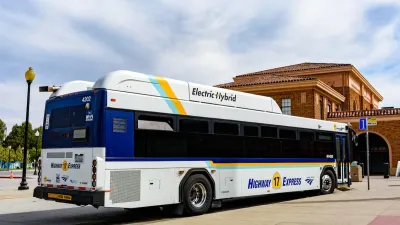Every so often, one sees an article arguing that one mode of transportation is cheaper, more efficient, or less dangerous than another because it uses less energy/kills more people/costs more per passenger-mile. (1) It seems to me, however, that per passenger-mile comparisions are flawed in one key respect: they assume that trips on any mode of transportation will involve the same mileage, so that if the average driver lives 20 miles from work, the average bus rider will also live 20 miles from work.
Every so often, one sees an article arguing that one mode of
transportation is cheaper, more efficient, or less dangerous than another
because it uses less energy/kills more people/costs more per passenger-mile. (1)
It seems to me, however, that per passenger-mile
comparisions are flawed in one key respect: they assume that trips on any mode
of transportation will involve the same mileage, so that if the average driver
lives 20 miles from work, the average bus rider will also live 20 miles from
work.
This assumption does not square with empirical reality. In the real world, people who live far from
work tend to drive more often than people will live closer to work; the combination of long distances and the existence of multiple stops makes public transit far less convenient for someone who lives 10 miles from work than for someone who lives 2 miles from work. This is true even where transit service extends far into suburbia. For example, in
Toronto, which has a long-distance commuter train system, 58 percent of commuters living less than 1 kilometer (0.6 miles) from
work use non-automotive transport, as opposed to 35 percent living 1-4
kilometers (0.6 miles to 2.5 miles) away, and only 22 percent living more than
15 kilometers (9 miles) away.
In cities
lacking long-distance commuter train systems, the differences between
short-distance and long-distance commuters are even greater. In Edmonton,
for example, 25 percent of people living 1-4 kilometers from work commute by foot, transit or bike,
as opposed to only 2 percent of people living 15 kilometers or more from work.(2)
So in the real world of city planning, our choices are not between a city of 20-mile bus commutes and a city of 20-mile car commute. Rather, our choice is: do we want to make cities more compact, thus increasing the number of short commutes (some of which will typically involve transit, for the reasons stated above) or do we want to create a relatively spread-out city with lots of long commutes (most of which will usually be by car)?
In the compact city, fewer passenger-miles will be traveled, which means that all the negative externalities of travel (e.g. pollution, collisions, public costs) will be lower. And because people will be somewhat more likely to use transit and carpool, both cars and transit vehicles will be more fuel-efficient, because cars and buses are more fuel-efficient when they have more passengers. By contrast, in the car-oriented, spread-out city, both car and transit commutes will typically be longer, and both cars and buses will have fewer passengers.
(1) For anti-transit
examples, see http://www.cato.org/pub_display.php?pub_id=9325
http://saveportland.com/Car_Vs_Tri-Met/energy-cost-death-02d.htm
; for a pro-transit example, see http://hugeasscity.com/2009/03/22/your-co2-emissions-per-mile-may-vary/
(2) http://www12.statcan.gc.ca/english/census06/analysis/pow/pdf/97-561-XIE2006001.pdf
at 34-35.

Planetizen Federal Action Tracker
A weekly monitor of how Trump’s orders and actions are impacting planners and planning in America.

Chicago’s Ghost Rails
Just beneath the surface of the modern city lie the remnants of its expansive early 20th-century streetcar system.

San Antonio and Austin are Fusing Into one Massive Megaregion
The region spanning the two central Texas cities is growing fast, posing challenges for local infrastructure and water supplies.

Since Zion's Shuttles Went Electric “The Smog is Gone”
Visitors to Zion National Park can enjoy the canyon via the nation’s first fully electric park shuttle system.

Trump Distributing DOT Safety Funds at 1/10 Rate of Biden
Funds for Safe Streets and other transportation safety and equity programs are being held up by administrative reviews and conflicts with the Trump administration’s priorities.

German Cities Subsidize Taxis for Women Amid Wave of Violence
Free or low-cost taxi rides can help women navigate cities more safely, but critics say the programs don't address the root causes of violence against women.
Urban Design for Planners 1: Software Tools
This six-course series explores essential urban design concepts using open source software and equips planners with the tools they need to participate fully in the urban design process.
Planning for Universal Design
Learn the tools for implementing Universal Design in planning regulations.
planning NEXT
Appalachian Highlands Housing Partners
Mpact (founded as Rail~Volution)
City of Camden Redevelopment Agency
City of Astoria
City of Portland
City of Laramie






























